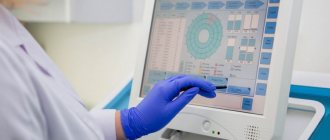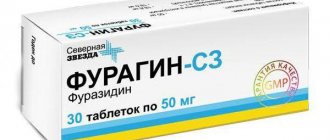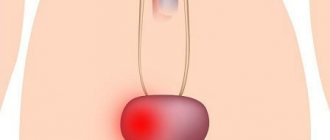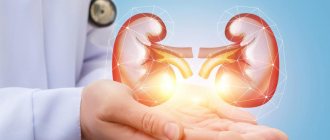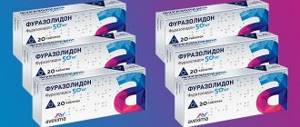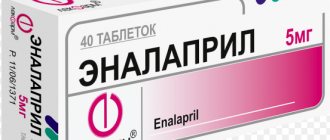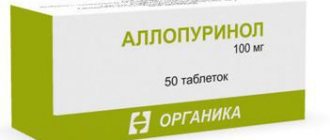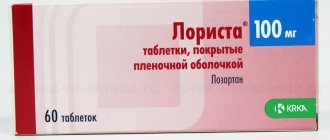Furadonin refers to drugs derived from nitrofurans that have an antimicrobial effect. However, Furadonin does not belong to the group of antibiotics.
It has a bacteriostatic and bactericidal effect on bacteria such as Klebsiella, Staphylococcus, Enterococcus, Escherichia coli, Proteus, Enterobacter, etc.
The instructions indicate that the main purpose of Furadonin is to treat urinary tract diseases caused by pathogenic microflora.
The drug has good absorption from the gastrointestinal tract, can penetrate the placenta, enter breast milk and cerebrospinal fluid.
The remaining substances are removed from the body through the kidneys. When using Furadonin, urine may acquire a dark tint. When taking a standard dose of the drug, the concentration in the blood is insignificant.
Release forms
Furadonin is sold in pharmacies with a prescription. Available in the following forms:
It is important to note that treatment with Furadonin can be afforded by a representative of any population group, since it is quite inexpensive.
Storage conditions
The drug must be stored in a dry, dark place, out of reach of children, at temperatures up to +25 C. The shelf life is indicated on the packaging.
Advantage over antibiotics
The use of Furadonin for cystitis is more justified than antibiotics. This drug acts selectively, destroying only individual strains of microorganisms, while antibiotics affect all flora without exception - both harmful and beneficial.
In addition to its antimicrobial effect, Furadonin has the ability to activate immune processes in the body, accelerate wound healing and help in the treatment of inflammation of other internal organs. This is due to the fact that the drug increases the ability of blood leukocytes to find and destroy foreign agents, and also has a positive effect on the cleansing function of the liver. Antibiotics, on the contrary, have a depressing effect on the immune system.
We suggest you familiarize yourself with First aid for cystitis in women at home, first aid for cystitis at home
During treatment with Furadonin, there were no cases of addiction to the action of the drug. This medicine is successfully used in the treatment of relapses of the disease and for preventive purposes. While the body sooner or later stops responding to most antibiotics.
Contraindications
Contraindications to this drug will be the presence of the patient:
- hypersensitivity to nitrofurantoin;
- renal failure;
- chronic hepatitis, liver cirrhosis;
- heart failure degree II-III;
- deficiency of B vitamins;
- genetic deficiency of the enzyme glucose-6-phosphate dehydrogenase;
- pregnancy and lactation;
- acute porphyria;
- purulent inflammation of the perinephric tissue.
Also, the drug is not prescribed to children under the age of 1 month.
It should be noted that Furadonin does not treat a disease such as glomerulonephritis.
For the following diseases, prescribe with caution:
Use of the drug during pregnancy and lactation
A pregnant or breastfeeding woman should make an informed decision about the use of any drug. The balance of benefit and risk is especially important in the first 12 weeks when the main systems and organs of the unborn child are formed. The free penetration of Furadonin through the placental barrier and into breast milk, as well as insufficient clinical trials regarding toxic effects on the fetus, have determined contraindications for its use during pregnancy and lactation.
Gynecologists usually use this drug in the treatment of urinary tract infections in the second half of pregnancy.
Possible side effects
Furadonin may cause the following side effects:
- Allergic reactions in the form of urticaria, Quincke's edema, skin itching. Extremely rare – anaphylaxis (rapid development of an allergic reaction that threatens the patient’s life).
- From the respiratory system in the form of cough, shortness of breath, chest pain. It is possible to develop interstitial pneumonitis or fibrosis (lung tissue is replaced by connective tissue). Lung capacity may decrease. Patients with bronchial asthma often have attacks of the disease.
- On the part of the digestive system, they manifest themselves in the form of lack of appetite, discomfort in the upper abdomen, nausea, and vomiting. Rarely in the form of hepatitis, manifestations of cholestatic jaundice (difficulty in the outflow of bile), abdominal pain, diarrhea.
- From the nervous system they manifest themselves in the form of headache, lethargy, dizziness, nystagmus (involuntary eye movements), polyneuropathy.
- On the part of the hematopoietic organs, it is expressed by a decrease in leukocytes and platelets, a complete absence or decrease in the number of granulocytes. Possible manifestations of hemolytic anemia (due to the destruction of red blood cells), megaloblastic anemia. These conditions are reversible.
- On the skin side, manifestations of exfoliative dermatitis (an inflammatory disease expressed in the detachment of the surface layer of the skin), erythema multiforme (a disease of an infectious-allergic nature) are possible.
Other possible side effects: urinary tract superinfection, arthralgia (joint pain), drug fever, chills, bone aches, weight loss, ringing in the ears, itching and vaginal discharge.
The most common reaction of the body to an overdose of Furadonin is vomiting. In this case, dialysis may be prescribed, as well as drinking plenty of fluids.
Side effects and overdose of Furadonin
At the early stage of treatment with Furadonin, there may be an exacerbation of side effects that have a detrimental effect on the general condition. Thus, allergic reactions (rash, swelling, itching) and digestive disorders (vomiting, nausea) may progress, but more serious clinical abnormalities cannot be excluded, in particular, pancreatitis, hepatitis and pseudomembranous enterocolitis develop.
In addition, it is necessary to take into account the fact that if the detailed instructions are not followed, an overdose of this medication is possible. In such cases, the patient “opens” vomiting, to prevent which it is advisable to take copious amounts of liquid to enhance the excretion (removal) of Furadonin.
Instructions for use
How to take Furadonin?
- Furadonin has a bitter taste. The tablets do not require chewing; they must be taken with plenty of liquid (at least 1 glass).
- Before use, shake the suspension and pour the required dose of medication into a measuring container.
- The suspension can be mixed with milk, water or juice.
- Taking Furadonin with meals will help relieve discomfort in the gastrointestinal tract.
- When taking Furadonin with food, you should remember that its effect will be enhanced in an acidic environment, so the diet should contain more protein products.
The prescription of Furadonin and dose selection should be made by a doctor. The dosage may vary depending on the disease for which the drug is taken.
For adults, the usual dose is 50 to 100 mg 4 times daily. The course of therapy is 5-8 days, but if necessary, the doctor can extend it to 10 days.
If the effect of treatment does not occur, further use of the drug is inappropriate.
Preventive, anti-relapse therapy can last from 3 to 12 months. In this case, the dosage is 1-2 mg per 1 kg of patient weight. For prevention, the drug is usually taken once a day before going to bed.
Briefly about cystitis
The causes of cystitis include:
- Infections: fungal, viral, bacterial.
- A decrease in the body's defenses due to radiation sickness, diabetes, taking hormonal drugs, as well as antitumor drugs.
In addition, cystitis can develop due to stagnation of urine, impaired metabolism and pathologies in the circulatory system.
Often, even after effective treatment, the disease returns. Relapses can be caused by gynecological problems, dysbacteriosis, hypothermia, general malaise, emotional overload, frequent constipation and abortions.
special instructions
In pediatric practice, Furadonin can be prescribed to children over the age of 1 month. The daily dose is 5-7 mg per 1 kg of body weight.
For children under 12 years of age, the daily dose of the medication is divided into 4 doses. At older ages, children take 100 mg 2 times a day for 5-7 days.
Since Furadonin can cross the placenta, there is a risk of negative effects on the fetus. Therefore, its use during pregnancy is not allowed, especially in the early stages.
During testing of the drug on animals, its risk to the fetus was identified. Clinical studies have not been conducted in pregnant women.
Sometimes a gynecologist can prescribe Furadonin to a pregnant woman after 12 weeks . In such cases, the doctor must evaluate the possible negative effects on the fetus and the therapeutic effect and decide whether the drug can be taken by a particular patient.
Price
| A drug | price, rub. |
| 50 mg, 10 pcs. | 50-60 |
| 50 mg, 20 pcs. | 80-90 |
| 100 mg, 20 pcs. | 160-189 |
The drug "Furadonin" is distinguished by its affordable cost. So, 50 tablets of 50 mg will cost 60 rubles, 10 tablets of the same dosage will cost about 40 rubles, and the price of 20 tablets of 100 mg is 80 rubles. Buying medications online will cost a little more.
Furadonin for cystitis
Furadonin can be prescribed to adults and children for the treatment of acute and chronic cystitis.
Before starting therapy, it is necessary to do a urine culture to identify the pathogen and determine its sensitivity to the antibiotic. In case of chronic cystitis, it is recommended to do sowing at each exacerbation, because The pathogen and its sensitivity may vary.
The dosage of Furadonin, as indicated in the instructions for use, for the treatment of cystitis is standard.
- In adults, 50-100 mg 4 times a day, 7-10 days.
- The pediatric dose is prescribed based on the child’s weight: 5-8 mg per 1 kg of body weight.
- For maintenance or preventive therapy for chronic cystitis, it will be 50-100 mg once a day for a treatment duration of 3 to 12 months.
Description of the drug
In the instructions you can read that the product has a bactericidal and bacteriostatic effect on microorganisms that cause cystitis.
Well absorbed in the digestive tract, excreted through the kidneys. The medicine can pass into breast milk, through the placenta and the blood-brain barrier. Mechanism of action: the drug disrupts the synthesis of protein substances in the microbial cell. It is used for the following diseases of the genitourinary system:
- cystitis;
- pyelonephritis;
- urethritis;
- prevention of complications before surgical interventions on the urinary tract.
Release form: tablets containing 50 or 100 mg of nitrofurantoin.
Drug interactions
It is not recommended to combine Furadonin with nalidixic acid and antacids . The presence of magnesium trisilicate in them reduces the absorption of Furadonin, and its effectiveness in treatment also decreases.
Taking the drug with Sulfinpyrazone and Probenecid is also not indicated, since it is possible to reduce the excretion of Furadonin in the urine.
This can lead to an increase in the concentration of the drug in the blood, an increase in its toxic effect and a decrease in the therapeutic effect.
It is not recommended to take Furadonin and Nevigramon together, as the effect of Furadonin will decrease. Avoid simultaneous use of Furadonin with drugs that may adversely affect renal function.
An alkaline environment reduces the effect of Furadonin, so it should not be compatible with medications that increase urine pH .
It is not recommended to take Furadonin in parallel with Sulfinpyrazone and probenecid.
Drinking alcohol while undergoing treatment with Furadonin is prohibited.
Furadonin can be used to treat both acute and chronic forms of cystitis.
This medicine is easily absorbed by the body and is quickly excreted in the urine. During the period of use, its concentration in the blood is quite insignificant. Due to the fact that furadonin is highly soluble in various liquids, it can give the urine a darker shade (brownish color).
Furadonin has not only high activity against these types of pathogens, but also against other infections.
This drug is also active against most strains of bacteria:
- Staphylococcus aureus;
- gram-positive aerobes;
- enterococci;
- gram-negative aerobes.
Look at this article: Amoxiclav - a remedy for the treatment of cystitis
The drug itself is produced in the form of small yellow tablets that taste bitter. Also, this medicine, in addition to treating cystitis, can be prescribed for bacterial infection of the urinary system: pyelitis, cystitis, urethritis, pyelonephritis, or as a prophylactic against infections.
Furadonin's analogs
Due to the lack of structural analogues of Furadonin, its analogues include drugs that are similar in therapeutic effect and are derivatives of nitrofuran:
- Furagin (is an antimicrobial drug, a derivative of nitrofuran. In some cases, this drug is even more effective, and the side effects are not so pronounced.);
Only the attending physician can decide what to replace Furadonin with when conducting therapy for a particular patient.
Indications and contraindications for the use of Furadonin
Furadonin is recommended for the treatment of infectious and inflammatory pathologies of the urinary tract caused by the activity of pathogenic microorganisms. Such diseases are pyelitis, urethritis, pyelonephritis and cystitis. In addition, this antibacterial drug acts as an effective prophylaxis during urological operations, catheterization and cytoscopy.
Like all antibiotics, Furadonin has its contraindications, which significantly narrow the circle of potential patients. Thus, this antiseptic is not approved for use by persons with hypersensitivity to its components, with the dominance of chronic renal and heart failure, as well as in the case of chronic hepatitis and pregnancy. It is important to note that during pregnancy, the use of Furadonin increases the risk of hemolytic anemia in the newborn.
Antimicrobial agents Furadonin - review
Greetings!
I often suffer from cystitis, I already have this disease as a chronicle.
Perhaps cystitis is one of the most terrible diseases - some will say “it’s just cystitis,” but for others it’s pain and cramping in the genitourinary system, leading to frenzy, a constant feeling as if you want to go to the toilet, but when going to a few drops are squeezed out from the toilet with the most unpleasant sensations, and for some it even happens with blood! And these sensations, this pain do not leave a person for a minute! I just want to climb the walls and howl at the moon when cystitis comes to me. But if you just freeze or get caught in a draft, the sore won’t take long to appear. In general, I would not want anyone to face such a problem.
Some kind person came up with a cure for cystitis, tablets FURADONIN. It is these and only these tablets that relieve symptoms on the first day of use. This is just a miracle.
Furadonin – review
Furadonin is
Antimicrobial agent, a derivative of the nitrofuran group, primarily for the treatment of urinary tract infections. It disrupts protein synthesis in bacteria and the permeability of the cell membrane.
Active against gram-positive and gram-negative bacteria (Staphylococcus spp., Streptococcus spp., Shigella dysenteria spp., Shigella flexneri spp., Shigella boydii spp., Shigella sonnei spp.
, Escherichia coli, Proteus spp.).
Indications for use:
- bacterial urinary tract infections (pyelitis, pyelonephritis, urethritis, cystitis);
- prevention of infections during urological operations or examinations (cystoscopy, catheterization, etc.).
Furadonin – review
There are 20 tablets of 100 mg in a package, they also come in smaller dosages, but then you need to drink them in larger quantities. I always take a dosage of 100.
active ingredient – nitrofurantoin
The shelf life of the tablets is quite long, up to 5 years.
Furadonin – review
If it’s lying around in the medicine cabinet, then, in any case, you will find this medicine before the expiration date expires. Inside the pack there are 2 blisters of 10 tablets each.
Furadonin – review
Contraindications:
Severe renal excretory dysfunction, renal failure, oliguria, glucose-6-phosphate dehydrogenase deficiency, pregnancy, early childhood (up to 1 month), hypersensitivity to nitrofurantoin, stage II-III heart failure, liver cirrhosis, chronic hepatitis, acute porphyria, lactation.
I can argue about contraindications for lactation. In our country, few experiments are done on women in this group, so most of the drugs have contraindications during lactation.
There is such a wonderful site e-lactation (Spanish site or Ukrainian), where you can find a great variety of medications and their compatibility with breastfeeding.
So it says there that Furadonin is compatible with GW.
Furadonin – review
During the period of breastfeeding, I had cystitis, and I took this drug. Neither I nor my child experienced any side effects, no one felt bad.
Furadonin – review
Directions for use and dosage:
The dose for adults is 50-100 mg, the frequency of use is 4 times a day. The daily dose for children is 5-7 mg/kg in 4 divided doses. The duration of treatment is 7 days. If necessary, it is possible to continue treatment for another 3 days (only after checking the urine for sterility). During long-term maintenance treatment, the dose of nitrofurantoin should be reduced.
I take 100 mg 3 times a day, I try for 7 days, but it doesn’t always work.
Side effects:
From the respiratory system: chest pain, cough, shortness of breath, pulmonary infiltrates, eosinophilia, interstitial pneumonitis or fibrosis, decreased respiratory function, attack of bronchial asthma in patients with a history of asthma.
From the digestive system: feeling of discomfort in the epigastrium, anorexia, nausea, vomiting; rarely - hepatitis, cholestatic jaundice, abdominal pain, diarrhea. From the central nervous system and peripheral nervous system: peripheral neuropathy, headache, nystagmus, dizziness, drowsiness.
From the hematopoietic system: leukopenia, granulocytopenia, agranulocytosis, thrombocytopenia, hemolytic anemia, megaloblastic anemia (these changes are reversible). Allergic reactions: urticaria, Quincke's edema, skin itching, rash; very rarely - anaphylactic shock.
Dermatological reactions: exfoliative dermatitis, erythema multiforme. Other: drug fever, arthralgia, possible flu-like symptoms, superinfection of the genitourinary tract, most often caused by Pseudomonas aeruginosa.
There are many side effects described, but nothing has happened to me yet. I heard from friends that nausea occurred when taking furadonin. At most, I sometimes have an unpleasant taste in my mouth.
Furadonin – review
The tablets themselves are small, round and bitter. I drink plenty of water, and quickly, so as not to feel the taste.
Furadonin – review
The package contains an annotation, quite small, which is good news, otherwise in a long annotation you might lose half a day before you find what you need.
Interaction with other drugs:
The simultaneous use of nalidixic acid and antacids containing magnesium trisilicate reduces the antibacterial effect of nitrofurantoin. Nitrofurantoin is incompatible with fluoroquinolones.
When used simultaneously, drugs that block tubular secretion reduce the antibacterial effect of nitrofurantoin (by reducing the concentration of nitrofurantoin in the urine) and increase its toxicity (increasing the concentration in the blood).
Special instructions:
The risk of developing peripheral neuropathy increases in patients with anemia, diabetes mellitus, electrolyte imbalance, B vitamin deficiency, and severe renal failure.
Nitrofurantoin should not be used to treat diseases of the renal cortex, purulent paranephritis and prostatitis.
Nitrofurantoin is not prescribed in combination with drugs that cause renal impairment.
Furadonin – review
The pills are quite serious, and, like all the others, they cure one thing and cripple another. But the fact that they help better than other tablets for cystitis has been tested on me personally.
Now let's talk about concomitant treatment
First, and most importantly, is to keep your feet warm! Socks, then more socks on top, preferably wool or any other warm ones. Otherwise, if your feet are cold, treatment with pills will be of little use.
Secondly, you need to drink a lot of fluid so that all the crap is quickly washed out of the bladder. You can drink anything, even plain water, even tea, but the best folk remedy for the prevention of cystitis is cranberry. Therefore, cranberry juice will be an excellent assistant in the fight against the nasty disease.
Furadonin – review
Thirdly , a hot bottle between your legs will help relieve discomfort and warm up that very sore spot.
And fourthly, do not overcool, do not sit on the cold, do not get exposed to drafts and splits. Beware and beware again. Or better yet, wrap yourself in a blanket and lie in a warm bed until the illness subsides.
Conclusion
I tried different pharmaceutical medicines, and the best was and remains at the moment FURADONIN. Its effect is noticeable on the very first day of use, the unfortunate symptoms go away, no other medicine acts so quickly.
Checked! During pregnancy I had to take herbal pills and the symptoms did not go away in one day! Yes, there are many side effects, yes, they are serious pills, but if there are no contraindications, it is worth treating with them.
And don’t forget that you can use this drug during breastfeeding! Truly the best fighter against cystitis! Thank you all for your attention!
Source: https://irecommend.ru/content/luchshee-lekarstvo-ot-tsistitamozhno-li-furadonin-kormyashchim-mamamkakie-eshche-sredstva-po
Side effects
On the side of the scolio-intestinal tract:
boredom, vomiting, loss of appetite, frequency and intensity of which are dose dependent, abdominal pain, diarrhea, pancreatitis. Side effects on the side of the scolio-intestinal tract occur less often if the drug is taken with water, washed down with a large amount of radish.
On the side of the nervous system:
headache, drowsiness, confusion, depression, euphoria, nystagmus, confusion, psychotic reactions, restlessness (restlessness), asthenia, increased intracranial tension. In single episodes, there is serious and non-negotiable peripheral polyneuropathy (such as liver and liver in the legs, meat weakness), which is associated with nitric deficiency and trival congestion m large doses of the drug. If you have any symptoms, you need to take the drug.
On the side of the immune system:
hypersensitivity reactions, including autoimmune reactions, associated with chronic changes in the liver and legs, wolf-like syndrome.
The main symptoms of this wolfdog-like syndrome are fever, short-term visip, arthralgia and eosinophilia. An increase in the blood serum value is expected for more than two of these parameters: antinuclear antibodies, antibodies to smooth muscles or to glomeruli and Coombs test.
On the side of the dichotomy system:
Acute hypersensitivity reactions are characterized by indolent fever, eosinophilia, cough, chest pain, and shortness of breath. Legeneviy
infiltrate or worsening and pleural fluid may subside within a few years or days after the start of therapy; After taking the stink drug, take a look. Predatory or acute pulmonary symptoms, including pulmonary fibrosis, can rapidly develop in patients who take medicinal therapy; Fibrosis may not be reversible, especially if therapy is continued after symptoms appear.
Patients with bronchial asthma may experience asthmatic attacks. If first signs of disruption of the dichotomy system appear, it is necessary to take the drug.
On the side of the liver and/or the yellowish paths:
hepatitis, cholestatic hepatitis (dosage-dependent and known after discontinuation of the drug), cholestatic dysfunction of the liver.
From the side of the vessel:
hyperemia, circulatory collapse.
On the side of the skin and under the skin
: hypersensitivity reactions: scalp rash, maculopapular rash, urticaria, itching, hair loss;
in several types: angioedema, anaphylaxis, inflammation of the skin, eczema, exfoliative dermatitis, multimorphic erythema (Stevens-Johnson syndrome) ,
wolf-like syndrome.
On the side of the hematopoietic and lymphatic systems
: megaloblastic anemia, leukopenia, granulocytopenia or agranulocytosis, thrombocytopenia, aplastic anemia, hemolytic anemia in patients with glucose-6-phosphate dehydrogen deficiency zi.
Damage to skeletal-meat and tissue tissue
: gout, myalgia, pain in the throat.
Infections and infestations
: pseudomembranous colitis, fungal superinfection.
On the side of the organ of the eye:
destruction of the dawn.
On the side of the state organs and mammary ovum:
transient disruption of spermatogenesis.
Inshi:
Resistance to microorganisms such as
Pseudomonas
.

